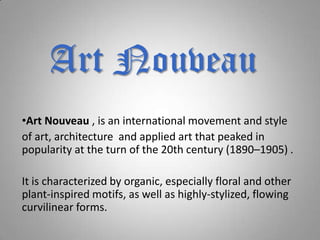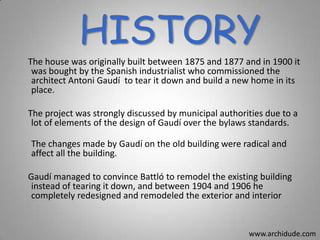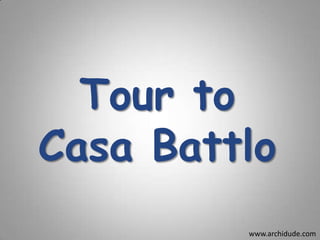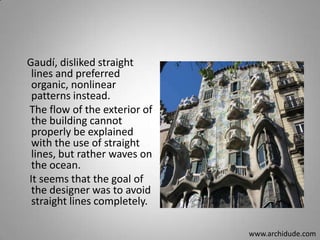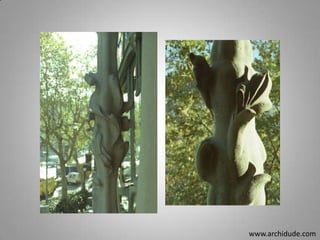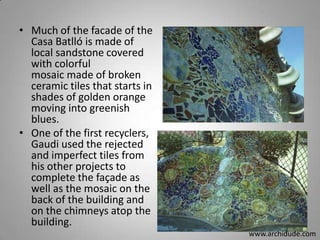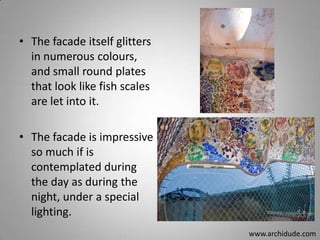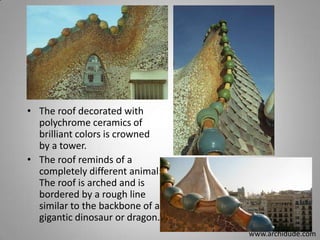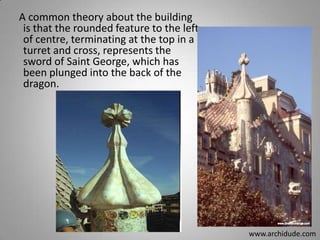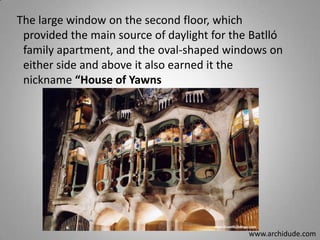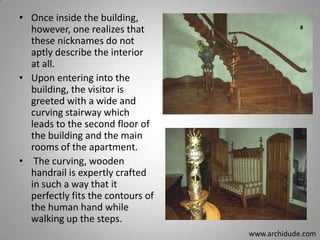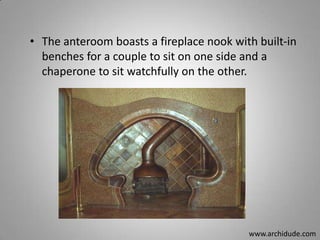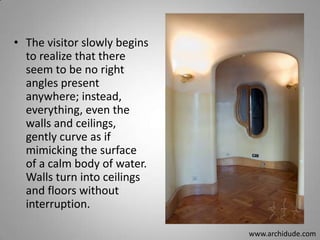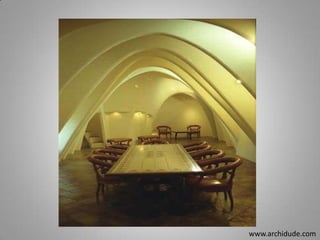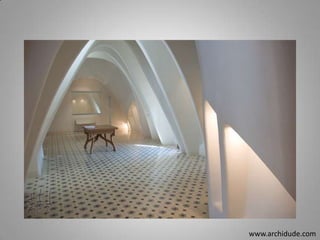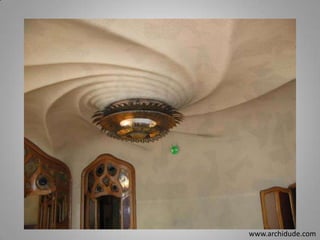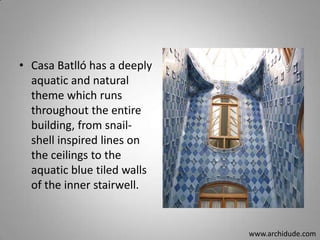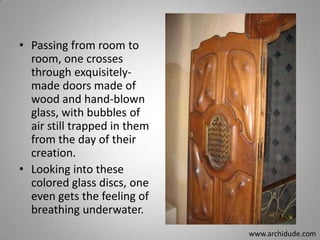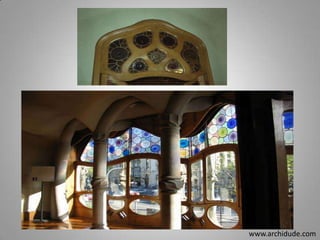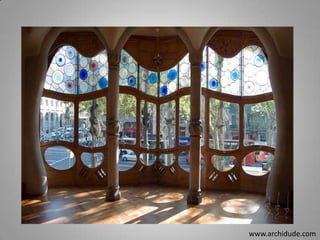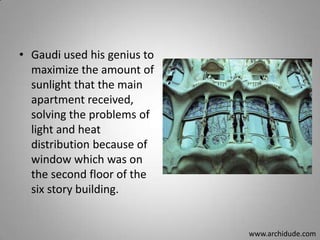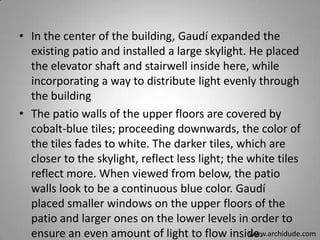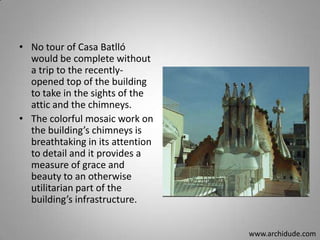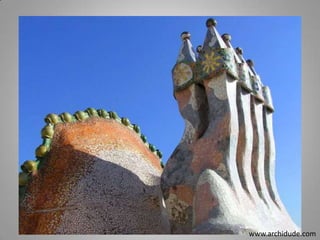Artnoveau
- 1. Art Nouveau •Art Nouveau , is an international movement and style of art, architecture and applied art that peaked in popularity at the turn of the 20th century (1890–1905) . It is characterized by organic, especially floral and other plant-inspired motifs, as well as highly-stylized, flowing curvilinear forms.
- 2. Art Nouveau is an approach to design according to which artists should work on everything from architecture; interior design; jewelry, furniture, textiles, to household silver and other utensils, making art part of everyday life. In French it refers to 'new art’. Art Nouveau was underlined by a particular way of thinking about modern society and new production methods, attempting to redefine the meaning and nature of the work of art, so that art would not overlook any everyday object, no matter how utilitarian. Hence the name Art Nouveau - "New Art". In German it is also known as Jugendstil for 'youth style', named after the magazine Jugend, which promoted it, especially as a graphic artform. www.archidude.com
- 3. In architecture, hyperbolas and parabolas in windows, arches, and doors are common, and decorative moldings 'grow' into plant-derived forms. Though Art Nouveau designers selected and 'modernized' some of the more abstract elements of Rococo style, such as flame and shell textures, they also advocated the use of highly stylized organic forms as a source of inspiration, expanding the 'natural' regularity to embrace seaweed, grasses, and insects. www.archidude.com
- 4. Although Art Nouveau fell out of favor with the arrival of 20th-century modernist styles, it is seen today as an important bridge between the history and modernism. Furthermore, Art Nouveau monuments are now recognized by UNESCO on their World Heritage List as significant contributions to cultural heritage. Art Nouveau's fifteen-year peak was strongly felt throughout Europe—but its influence was global. Hence, it is known in various guises with frequent localized tendencies. www.archidude.com
- 5. Casa Batlló ( pronounced Casa Batyo) Architect Antoni Gaudi Location Barcelona, Spain Date 1905 to 1907 timeline Building type Apartment building (remodel) Construction system Concrete Climate Mediterranean Context Urban Style Expressionist or Art Nouveau www.archidude.com
- 6. HISTORY The house was originally built between 1875 and 1877 and in 1900 it was bought by the Spanish industrialist who commissioned the architect Antoni Gaudí to tear it down and build a new home in its place. The project was strongly discussed by municipal authorities due to a lot of elements of the design of Gaudí over the bylaws standards. The changes made by Gaudí on the old building were radical and affect all the building. Gaudí managed to convince Battló to remodel the existing building instead of tearing it down, and between 1904 and 1906 he completely redesigned and remodeled the exterior and interior www.archidude.com
- 7. • Gaudí added a gallery, the balconies and the polychrome ceramics. • Inside, the spaces were totally reorganized in order to obtain in it more natural light and ventilation. • Gaudí also added two floors to the building. • Outside, Gaudí carried out one of the most impressive and brilliant urban façades of the world. • He used for it the typical modern constructive elements such as the ceramics, the stone and the iron forged. • Awarded as one of the three best buildings of the year 1906 by the Barcelona city Council. www.archidude.com
- 9. Gaudí, disliked straight lines and preferred organic, nonlinear patterns instead. The flow of the exterior of the building cannot properly be explained with the use of straight lines, but rather waves on the ocean. It seems that the goal of the designer was to avoid straight lines completely. www.archidude.com
- 10. • A facade includes a number of small, elegantly curved balconies that seem to stick to the front of the house like birds' nests on the face of the cliff. • There are no edges or corners; even the walls are rounded giving the essence of smooth skin of a sea serpent about them. • The balconies remember pieces of skulls with its eyes and mouth. • The columns of first floor look like human bones • The local name for the building is Casa dels ossos (house of bones), and indeed it does have a visceral, skeletal organic q uality. www.archidude.com
- 12. • Much of the facade of the Casa Batlló is made of local sandstone covered with colorful mosaic made of broken ceramic tiles that starts in shades of golden orange moving into greenish blues. • One of the first recyclers, Gaudi used the rejected and imperfect tiles from his other projects to complete the façade as well as the mosaic on the back of the building and on the chimneys atop the building. www.archidude.com
- 13. • The facade itself glitters in numerous colours, and small round plates that look like fish scales are let into it. • The facade is impressive so much if is contemplated during the day as during the night, under a special lighting. www.archidude.com
- 15. • The roof decorated with polychrome ceramics of brilliant colors is crowned by a tower. • The roof reminds of a completely different animal: The roof is arched and is bordered by a rough line similar to the backbone of a gigantic dinosaur or dragon. www.archidude.com
- 16. A common theory about the building is that the rounded feature to the left of centre, terminating at the top in a turret and cross, represents the sword of Saint George, which has been plunged into the back of the dragon. www.archidude.com
- 17. The large window on the second floor, which provided the main source of daylight for the Batlló family apartment, and the oval-shaped windows on either side and above it also earned it the nickname “House of Yawns www.archidude.com
- 18. • Once inside the building, however, one realizes that these nicknames do not aptly describe the interior at all. • Upon entering into the building, the visitor is greeted with a wide and curving stairway which leads to the second floor of the building and the main rooms of the apartment. • The curving, wooden handrail is expertly crafted in such a way that it perfectly fits the contours of the human hand while walking up the steps. www.archidude.com
- 19. • The anteroom boasts a fireplace nook with built-in benches for a couple to sit on one side and a chaperone to sit watchfully on the other. www.archidude.com
- 20. • The visitor slowly begins to realize that there seem to be no right angles present anywhere; instead, everything, even the walls and ceilings, gently curve as if mimicking the surface of a calm body of water. Walls turn into ceilings and floors without interruption. www.archidude.com
- 24. • Casa Batlló has a deeply aquatic and natural theme which runs throughout the entire building, from snailshell inspired lines on the ceilings to the aquatic blue tiled walls of the inner stairwell. www.archidude.com
- 25. • Passing from room to room, one crosses through exquisitelymade doors made of wood and hand-blown glass, with bubbles of air still trapped in them from the day of their creation. • Looking into these colored glass discs, one even gets the feeling of breathing underwater. www.archidude.com
- 28. • Gaudi used his genius to maximize the amount of sunlight that the main apartment received, solving the problems of light and heat distribution because of window which was on the second floor of the six story building. www.archidude.com
- 29. • In the center of the building, Gaudí expanded the existing patio and installed a large skylight. He placed the elevator shaft and stairwell inside here, while incorporating a way to distribute light evenly through the building • The patio walls of the upper floors are covered by cobalt-blue tiles; proceeding downwards, the color of the tiles fades to white. The darker tiles, which are closer to the skylight, reflect less light; the white tiles reflect more. When viewed from below, the patio walls look to be a continuous blue color. Gaudí placed smaller windows on the upper floors of the patio and larger ones on the lower levels in order to www.archidude.com ensure an even amount of light to flow inside.
- 31. • No tour of Casa Batlló would be complete without a trip to the recentlyopened top of the building to take in the sights of the attic and the chimneys. • The colorful mosaic work on the building’s chimneys is breathtaking in its attention to detail and it provides a measure of grace and beauty to an otherwise utilitarian part of the building’s infrastructure. www.archidude.com

